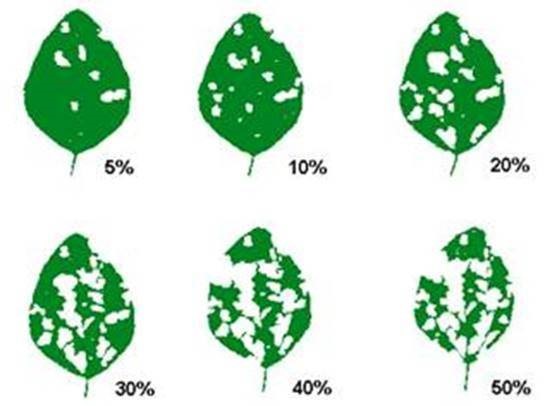It appears that 2019 could be a very heavy Japanese Beetle year. To prepare for dealing with this pest, below is some information on managing Japanese Beetles in both corn and soybeans:
Soybeans: Now that most of our soybeans are flowering, we should scout them for percent (%) defoliation. To determine if an insecticide application is needed, estimate the percent defoliation on randomly selected leaves in at least five different areas of the field. Here is an illustration that can help in determining % defoliation:
An insecticide application should be considered if:
- 1. Fifteen percent defoliation during flowering (or pod fill), and
- 2. Beetles are present and actively feeding.
If your soybean fields are flowering and have 15% defoliation from Japanese Beetles, I would recommend an insecticide (for example, Bayer recommends 2.8 oz. of Leverage® 360). An insecticide should give you both knockdown of the beetles in the field and also provide up to two to three weeks of in-plant residual control. A week after application you might see Japanese Beetles in the field, but they will not be feeding, and if you are also applying a fungicide, make sure it is compatible with the insecticide.
Corn: The Japanese Beetle adults will feed on corn leaves, tassels, silks and pollen. The adult beetles can eat enough leaf tissue to “window-pane” a leaf, but corn leaf feeding by the Japanese Beetle is rarely of economic importance. Where they play havoc in corn is when the beetles prevent pollination by clipping silks during pollination. When the silks are clipped before or during pollination the ears may be only partially pollinated.
Remember when scouting corn for Japanese beetles, you should always evaluate a representative portion of the field. If you only scout near field edges, where populations of Japanese beetles accumulate initially, the true population of beetles for that field might be overestimated.
An insecticide treatment should be considered during silking if you have these three things:
- Silks have been clipped to less than ½ inch
- Pollination is less than 50% complete
- Japanese beetles are still present and actively feeding
Again, choose an insecticide that is efficacious for controlling Japanese Beetle, if an application is warranted. And if you are also applying a fungicide, make sure it is compatible with the insecticide.

